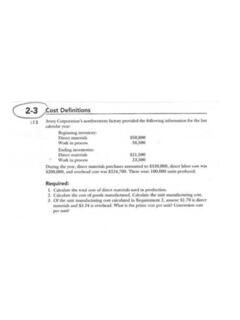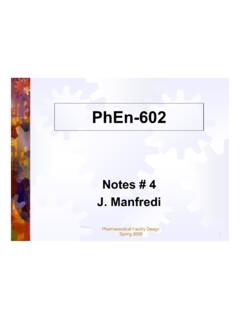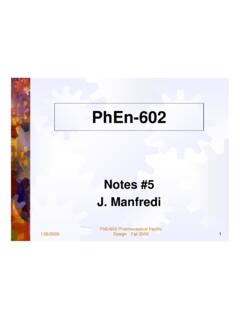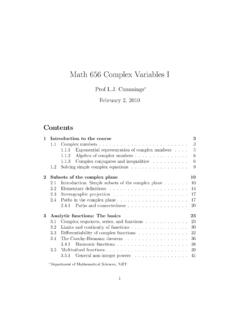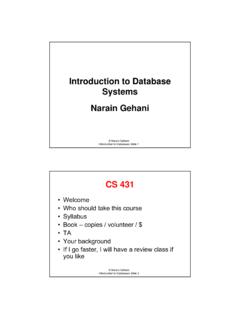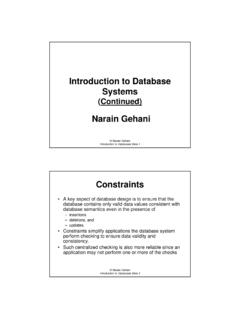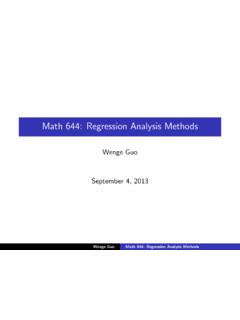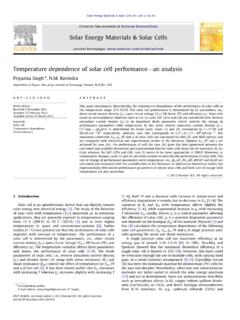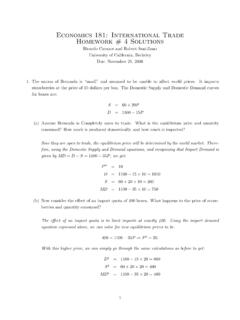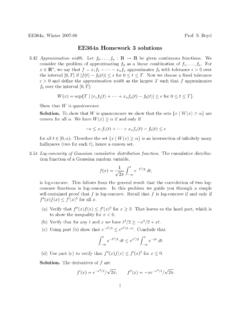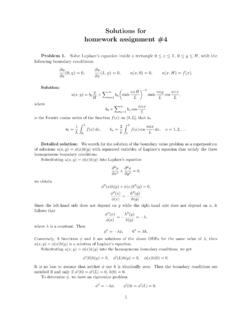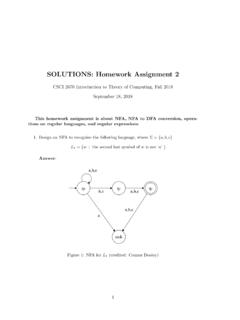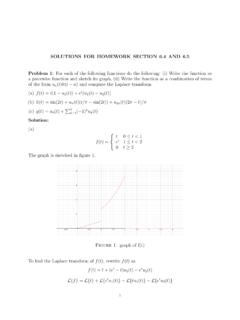Transcription of Homework 5 Solutions - New Jersey Institute of Technology
1 CS 341: Foundations of Computer Science II. Prof. Marvin Nakayama Homework 5 Solutions 1. Give context-free grammars that generate the following languages. (a) { w {0, 1} | w contains at least three 1s }. Answer: G = (V, , R, S) with set of variables V = {S, X}, where S is the start variable; set of terminals = {0, 1}; and rules S X1X1X1X. X 0X | 1X | . (b) { w {0, 1} | w = w R and |w| is even }. Answer: G = (V, , R, S) with set of variables V = {S}, where S is the start variable; set of terminals = {0, 1}; and rules S 0S0 | 1S1 | . (c) { w {0, 1} | the length of w is odd and the middle symbol is 0 }.
2 Answer: G = (V, , R, S) with set of variables V = {S}, where S is the start variable; set of terminals = {0, 1}; and rules S 0S0 | 0S1 | 1S0 | 1S1 | 0. (d) { ai bj ck | i, j, k 0, and i = j or i = k }. Answer: G = (V, , R, S) with set of variables V = {S, W, X, Y, Z}, where S is the start variable; set of terminals = {a, b, c}; and rules S XY | W. X aXb | . Y cY | . W aW c | Z. Z bZ | . 1. (e) { ai bj ck | i, j, k 0 and i + j = k }. Answer: G = (V, , R, S) with set of variables V = {S, X}, where S is the start variable; set of terminals = {a, b, c}; and rules S aSc | X. X bXc | . (f) { ai bj ck | i, j, k 0 and i + k = j }.
3 Answer: Let L = { ai bj ck | i, j, k 0 and i + k = j } be the language given in the problem, and de ne other languages L1 = { ai bi | i 0 }, L2 = { bk ck | k 0 }. Note that L = L1 L2 because concatenating any string ai bi L1 with any string bk ck L2 results in a string ai bi bk ck = ai bi+k ck L. Thus, if L1 has a CFG G1 = (V1 , , R1 , S1 ), and L2 has a CFG G2 = (V2 , , R2 , S2 ), we can construct a CFG for L = L1 L2 by using the approach in problem 3b, as suggested in the hint. Speci cally, L1 has a CFG G1 = (V1 , , R1 , S1 ), with V1 = {S1 }, = {a, b, c}, S1. as the starting variable, and rules S1 aS1 b | in R1.
4 L2 has a CFG G2 = (V2 , , R2 , S2 ), with V2 = {S2 }, = {a, b, c}, S2. as the starting variable, and rules S2 bS2 c | in R2 . Even though = {a, b, c} for both CFGs G1 and G2 , CFG G1 never generates a string with c, and CFG G2 never generates a string with a. Then from problem 3b, a CFG G3 = (V3 , , R3 , S3 ) for L has V3 = V1 V2 {S3 } = {S1 , S2 , S3 }. with S3 the starting variable, = {a, b, c}, and rules S3 S1 S2. S1 aS1 b | . S2 bS2 c | . (g) . Answer: G = (V, , R, S) with set of variables V = {S}, where S is the start variable; set of terminals = {0, 1}; and rules S S. Note that if we start a derivation, it never nishes, , S S S , so no string is ever produced.
5 Thus, L(G) = . (h) The language A of strings of properly balanced left and right brackets: every left bracket can be paired with a unique subsequent right bracket, and every right 2. bracket can be paired with a unique preceding left bracket. Moreover, the string between any such pair has the same property. For example, [ ] [ [ [ ] [ ] ] [ ] ] A. Answer: G = (V, , R, S) with set of variables V = {S}, where S is the start variable; set of terminals = {[, ]}; and rules S | SS | [S]. 2. Let T = { 0, 1, (, ), , , , e }. We may think of T as the set of symbols used by regular expressions over the alphabet {0, 1}; the only di erence is that we use e for symbol , to avoid potential confusion in what follows.
6 (a) Your task is to design a CFG G with set of terminals T that generates exactly the regular expressions with alphabet {0, 1}. Answer: G = (V, , R, S) with set of variables V = {S}, where S is the start variable; set of terminals = T ; and rules S S S | SS | S | (S) | 0 | 1 | | e (b) Using your CFG G, give a derivation and the corresponding parse tree for the string (0 (10) 1) . Answer: A derivation for (0 (10) 1) is S S (S) (S S) (0 S) (0 SS) (0 S S) . (0 (S) S) (0 (SS) S) (0 (1S) S) . (0 (10) S) (0 (10) 1) . and the corresponding parse tree is 3. S. S . ( S ). S S. 0 S S. S 1. ( S ). S S. 1 0. 3.
7 (a) Suppose that language A1 has a context-free grammar G1 = (V1 , , R1 , S1 ), and language A2 has a context-free grammar G2 = (V2 , , R2 , S2 ), where, for i = 1, 2, Vi is the set of variables, Ri is the set of rules, and Si is the start variable for CFG Gi . The CFGs have the same set of terminals . Assume that V1 V2 =.. De ne another CFG G3 = (V3 , , R3 , S3 ) with V3 = V1 V2 {S3 }, where S3 V1 V2 , and R3 = R1 R2 { S3 S1 , S3 S2 }. Argue that G3. generates the language A1 A2 . Thus, conclude that the class of context-free languages is closed under union. Answer: Let A3 = A1 A2 , and we need to show that L(G3 ) = A3.
8 To do this, we need to prove that L(G3 ) A3 and A3 L(G3 ). To show that L(G3 ) A3 , rst consider any string w L(G3 ). Since w L(G3 ), we . have that S3 w. Since the only rules in R3 with S3 on the left side are . S3 S1 | S2 , we must have that S3 S1 w or S3 S2 w. Suppose . rst that S3 S1 w. Since S1 V1 and we assumed that V1 V2 = , the . derivation S1 w must only use variables in V1 and rules in R1 , which implies . that w A1 . Similarly, if S3 S2 w, then we must have that w A2 . Thus, w A3 = A1 A2 , so L(G3 ) A3 . To show that A3 L(G3 ), rst suppose that w A3 . This implies w A1 or . w A2 . If w A1 , then S1 w.
9 But then S3 S1 w, so w L(G3 ). 4.. Similarly, if w A2 , then S2 w. But then S3 S2 w, so w L(G3 ). Thus, A3 L(G3 ), and since we previously showed that L(G3 ) A3 , it follows that L(G3 ) = A3 ; , the CFG G3 generates the language A1 A2 . (b) Prove that the class of context-free languages is closed under concatenation. Answer: Suppose that language A1 has a context-free grammar G1 = (V1 , , R1 , S1 ), and language A2 has a context-free grammar G2 = (V2 , , R2 , S2 ), where, for i = 1, 2, Vi is the set of variables, Ri is the set of rules, and Si is the start variable for CFG Gi . The CFGs have the same set of terminals.
10 Assume that V1 V2 = . Then a CFG for A1 A2 is G3 = (V3 , , R3 , S3 ) with V3 = V1 V2 {S3 }, where S3 V1 V2 , and R3 = R1 R2 { S3 S1 S2 }. To understand why L(G3 ) = A1 A2 , note that any string w A1 A2 can . be written as w = uv, where u A1 and v A2 . It follows that S1 u and . S2 v, so S3 S1 S2 uS2 uv, so w = uv L(G3 ). This proves that A1 A2 L(G3 ). To prove that L(G3 ) A1 A2 , consider any string w L(G3 ). Since w .. L(G3 ), it follows that S3 w. The only rule in R3 with S3 on the left side is . S3 S1 S2 , so S3 S1 S2 w. Since V1 V2 = , any derivation starting from S1 can only generate a string in A1 , and any derivation starting from S2.
